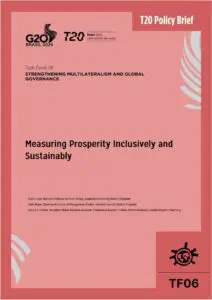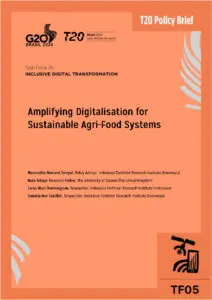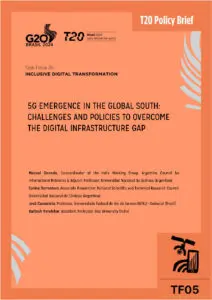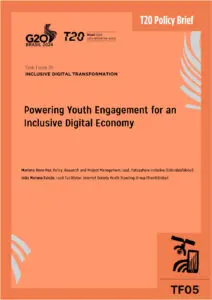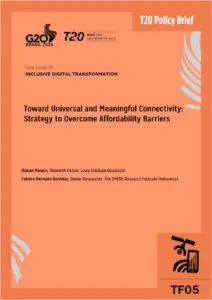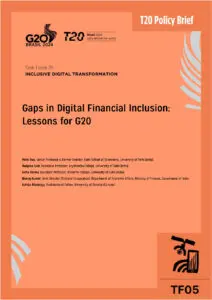In recent years the circular economy has received increasing attention worldwide due to, inter alia, the recognition that security of supply of resources and environmental sustainability are crucial for the prosperity of countries and businesses. G20 countries should consider developing frameworks that enhance the circular economy and more generally sustainable production and consumption modes. In this context, they should 1) integrate the circular economy into discussions about implementing the 2030 Agenda for Sustainable Development and the Paris Agreement, 2) work towards agreed terminologies for circular economy products and processes, 3) support demand for circular economy products and services, 4) support transparency across global supply chains, 5) facilitate financing for establishing circular supply chains and 6) proactively address the transition issues.
Challenge
Over the past few years the circular economy has managed to achieve broad appeal among a diverse global audience, including business leaders, policy-makers and academics. The concept has gained currency to a large extent because it is viewed as a solution for addressing concerns over rising global pressure on resources as well as for reconciling what is sometimes presented as conflicting objectives for economic growth and environmental sustainability. The potential economic benefits arising from using less energy and material inputs have been an important catalyst of business interest in the circular economy worldwide. In many cases the business interest has been fuelled by the commercial opportunities created by emerging disruptive business models, such as sharing[1] or product-as-a-service[2] models that challenge the traditional way of doing business and selling products. The expanding capacities of digital technologies, which are receiving special attention by the German presidency of the G20, have been a key driver of the adoption and proliferation of such disruptive business models (World Economic Forum et al., 2014; TechUK, 2015).
While many governments around the world, including the EU, have adopted circular economy strategies and programmes, there are multiple challenges that need to be resolved in the upcoming years. One issue concerns consumption patterns, which are a key driver of the circular economy transition. Despite the emergence of several circular products and services, demand for these solutions is still low, especially compared with products developed through linear business models (DSGC, 2015). Studies have identified the lack of demand for circular products or services as one of the key barriers to the circular economy (see Rizos et al., 2016). Governments must therefore adopt policies and measures to encourage demand for circular and green products and services and to stimulate the large-scale adoption of circular business models.
Another key challenge relates to the financial sector and financial products, from both the public and private sectors, which need to adapt to the changing environment. Indeed, the disruptive nature of most circular models requires a fine-tuning of financing methods, including leasing and insurance contracts. Several factors impact the risk profile of new circular business initiatives and curb their financeability: uncertainty about the value of products to be used as inputs in second-hand markets, balance sheet extension, the longer lifetime of assets and the cross-industry nature of circular models requiring a systemic risk analysis.
Achieving a large, industrial ‘circular’ transformation would also entail a major shift in our production and consumption patterns. For example, food production and consumption cannot be regarded as sustainable and a circular transition would require new production methods, different food supply chains and new approaches to consumption (Rood et al., 2017). These types of changes in the food and other sectors of the economy will in turn have a significant impact on national economies, the environment and society. There will be further effects on an international scale, since many advanced countries depend on imports of raw materials from low-income countries. Understanding these effects is crucial for G20 governments in developing and implementing future policies in the field.
[1] The term ‘sharing economy’ is often interchangeably used with the term ‘collaborative economy’. According to the European Commission (2016, p. 3), the collaborative economy “refers to business models where activities are facilitated by collaborative platforms that create an open marketplace for the temporary usage of goods or services often provided by private individuals”. Such models have been used, for example, in car sharing and accommodation services.
[2] ‘Product as a service’ refers to the concept of offering the product as a service, which challenges the traditional business approach of selling tangible products. It can be implemented through practices of leasing, renting, pay-per-use or performance-based business models (Tukker, 2004).
Proposal
In light of the challenges presented above, this policy brief provides a list of proposals for action to be taken by G20 countries in order to support the circular economy. The proposals are listed below, while the subsequent sections discuss the rationale behind these proposals.
List of proposals for action to be taken by G20 countries
- The G20 should integrate the circular economy into discussions about implementing the 2030 Agenda for Sustainable Development and the Paris Agreement.
- The G20 should collaboratively work towards agreed terminologies for products and processes relevant to the circular economy (e.g. remanufacturing, refurbishment, product life extension, reparability, reusability, etc.).
- On the basis of an agreed framework of terminologies, the G20 should develop and use a common framework of indicators to monitor the performance of countries and companies worldwide.
- G20 governments should use public procurement to support the demand for circular products and services, thereby taking into account the benefits occurring during the lifetime of products or services.
- G20 governments should also explore tax differentiation for circular products and services.
- A shift of taxation from labour to environmentally harmful activities, including resource use, can unlock opportunities for G20 countries.
- G20 governments should support transparency across global supply chains regarding the origins and content of circular products and materials (e.g. through supporting the development of standards and business-to-business labels).
- The G20 should ensure that actions in the sphere of investment promotion and investment facilitation address the circular economy as a key enabler to attain the Sustainable Development Goals. In particular, on top of enhancing predictability and consistency in the application of investment policies favouring circular models, the G20 should consider phasing out public international financing for industrial projects that do not respect resource-efficient principles.
- The G20 should invite multilateral development banks and national promotional banks to structure financial instruments by pooling circular economy projects in order to amass enough value and sufficient risk diversification to minimise transaction costs and facilitate the participation of institutional investors.
- The G20 should support the development of multi-stakeholder platforms and multilateral funds that provide guarantees for relevant pilot projects implementing circular solutions.
- The G20 could facilitate, in partnership with multilateral development banks, the creation of a new dataset with detailed information on loans to circular business models by facilitating and standardising the reporting of crediting institutions, with the aim of making information about systemic cross-industry risk, the residual value of products and performance of secondary markets accessible.
- It is important to assess the economic, environmental and social impacts of the transition to a circular economy, including the indirect effects on the economy. In these assessments special attention should be given to the social impacts as well as those on low-income third countries.
Integrate the circular economy into discussions about implementing the 2030 Agenda for Sustainable Development and the Paris Agreement
The circular economy should not be seen as a separate agenda, but should rather be embedded in discussions about implementing the 2030 Agenda for Sustainable Development and the Paris Agreement, which provide key international frames of reference. A transition towards a circular economy can contribute to achieving several[1] of the 17 Sustainable Development Goals (SDGs). One of the SDGs in particular, Goal 12, aims to “ensure sustainable consumption and production patterns” and is explicitly linked to resource efficiency, the reduction of waste generation (including from food and chemicals) and a decrease in fossil fuel subsidies. The G20 Action Plan on the 2030 Agenda for Sustainable Development, adopted at the G20 Hangzhou Summit in 2016, is framed around a list of Sustainable Development Sectors (SDS). Due to its multidimensional nature, the circular economy is relevant to several of these SDS: infrastructure, agriculture, food security and nutrition, industrialisation and inclusive business. Furthermore, there is a direct link between the use of natural resources and climate change, which indicates that the circular economy is also important for the climate change agenda and the Paris Agreement. Around 70% of global resource extraction eventually ends up in the atmosphere in the form of greenhouse gas emissions, making “the atmosphere by far the largest site for the disposal of global waste” (Behrens, 2016, p. 2).
Work towards agreed terminologies for circular products and processes
In recent years several governments have adopted strategies and government-wide programmes for a circular economy. Additionally, many companies are pursuing circular economy strategies and claim to integrate circular principles in their business models. However, in practice, the circular economy concept is interpreted in various ways by governments and is not applied consistently worldwide. This often creates confusion about the circular economy and its various processes (Rizos et al., 2017), and can also hinder the development of an international playing field.
In light of this issue, the G20 should collaboratively work towards agreed terminologies for products and processes relevant to the circular economy (e.g. remanufacturing, refurbishment, product life extension, etc.) with the aim of facilitating knowledge sharing among countries, reducing the risk of green-washing, and increasing opportunities for investing in circular economy projects and trading goods that can be considered ‘circular’ and are not hazardous. Most imporantly, this would also support the use of a common framework of indicators for a circular economy that would help in monitoring the circular economy performance of countries and companies worldwide. An example of international collaboration in the circular economy field is the EU–Vietnam Free Trade Agreement, which introduces the concept of remanufactured goods[2] and opens the way for trade in remanufactured goods that have a similar performance, working conditions and life expectancy when compared with the original new goods.
Encourage demand for circular economy products and services
Accounting for a significant part of overall demand for goods and services,[3] public procurement can provide a major demand pull for circular products and services and therefore support the development of circular economy markets. Around the globe, interest in introducing environmental criteria in the procurement process is on the rise as indicated by the emergence of many national political commitments, policies and programmes on green or sustainable public procurement. Still, evidence shows that there is large untapped potential for the use of this policy instrument (UNEP, 2013). With regard to the circular economy, an important issue concerns the influence of the purchase price in the contract award decision at the expense of circular solutions that can provide substantial benefits over the life cycle of products or services (Renda et al., 2012; Bergman et al., 2012). In this context, the award decision process should give more attention to the costs and net environmental benefits occurring during the lifetime of products or services.
Positive economic incentives (e.g. subsidies) can also encourage market pull for circular products and services. China, for example, has introduced reduced VAT rates for secondary raw materials (China Briefing, 2011; Ernst & Young, 2015). Tax incentives for companies that provide circular products or services could be another example of these types of measures. Such positive incentives can be combined with effective penalty-led approaches, for instance taxes on landfilling and incineration, in order to support the circular economy. Several organisations, along with the European Commission,[4] have stressed that many opportunities can be unlocked by shifting taxation from labour to environmentally harmful activities, including resource use.
Support transparency across global supply chains
Companies increasingly participate in an international marketplace and are involved in global supply chains involving multiple companies and actors. In such complex supply chains, closing material loops would require improved transparency throughout the supply chains regarding the origins and content of circular products and materials. Improved transparency would furthermore facilitate collaboration among different industries and companies along the supply chains (World Economic Forum et al., 2014; Vanner et al., 2014). In this context, the introduction of standards, developed in collaboration between governments and companies, can ensure the quality of circular products and processes and support greater transparency along the supply chains. To improve transparency, governments can also support the development of business-to-business labels, based on independent third-party verification, which indicate the origins and content of products and materials.
Facilitate financing for establishing circular supply chains
The role of businesses in the transition to a circular economy is pivotal. In the low-growth environment affecting several economies in the G20, potential growth estimates of 4 to 7% over the next decade for the circular economy represent good investment opportunities, which the private sector is ready to capitalise on.[5] The annual growth in market share of circular business models[6] indicates that the transformation is underway and that gains from cost savings and resource-efficient supply chains provide the right incentives to the business sector. Nonetheless, the role that governments can play in accelerating and supporting the transformation through access to finance is non-negligible. In this section we identify some of the areas of intervention in which fine-tuned policy-making can substantially make the difference.
Since 2000, public sector-led financing involving multilateral development banks (MDBs) and national promotional banks (NPBs) have put in place multi-stakeholder partnerships, innovative funds or schemes for blended financing targeted at the green economy, energy efficiency and sustainable infrastructure. Although increased volumes of financial assistance targeted at circular models would be welcome, the priority should be on reorienting investment strategies and revising eligibility criteria to ensure that circular supply chains can benefit from such schemes. One key example in this respect is offered by InnovFin, an EU programme for SMEs and midcaps, which had to expand its scope to organisational innovation on top of technological innovation in order to support innovative circular models (EIB, 2015). As the circular economy can support meeting several of the SDGs (e.g. Goal 12), financing schemes for development and sustainability should also explicitly provide room for financing the circular economy. Of course, that has different implications for the G20 economies, as in some cases the primary goal of financing is that of supporting industrial renewal and transformation, while in others it is developing a sustainable and circular infrastructure, which is considered a prerequisite for the flourishing of business opportunities.
Much can also be done by the public sector, NPBs and MDBs to leverage private funds and bring in institutional investors. Any action targeted at value creation and predictability in secondary markets as well as the pooling of small-scale projects into structured portfolios can substantially reduce the risk associated with innovative circular supply chains.
To ensure that public intervention is additional and to avoid crowding out private financing, assistance should be tailored to the different stages of development of circular models: i) minimal intervention to leverage private investment is appropriate in the context of advanced economies for circular models that are ready to be scaled up or replicated; ii) in less business-friendly environments, public–private partnerships and more substantial interventions in terms of financial and technical assistance might be needed (loans, equity and advisory services); and iii) for all those projects involving circular innovation not yet tested by the market, public sector guarantees seem more appropriate.
Furthermore, one of the objectives of public sector financing should be that of supporting schemes that favour collaboration across the value chain. In this context, the establishment of targeted financial instruments designed for chains or networks of businesses can provide a better framework for shared risk and benefits in the context of circular business (FinanCE, 2016).
Finally, policy-makers should focus their attention not only on providing incentives and clear rules for financial intermediaries, but also, as disintermediation is affecting the banking system, on removing barriers that can impede fintech and crowdfunding instruments from serving circular investment.
Proactively address the transition issues
Transforming the linear economy, which has remained the dominant model since the onset of the Industrial Revolution, into a circular one requires a major transformation of our production and consumption patterns, business practices, value chains and sectors. This in turn would entail impacts on the economy (e.g. net GDP, net employment, investment opportunities), the environment (e.g. decreased GHG emissions, decreased primary material consumption, avoided land use) and society (e.g. distributional impacts among different income groups) that are important to assess. It would also be imporant to assess the indirect effects on the economy (e.g. on the value chain or changes in consumption spending patterns) as well as the social repercussions of the transition to a circular economy (Rizos et al., 2017).
In this context, it is crucial to provide evidence about the processes and products that will likely benefit from this transition and those that might experience negative consequences and lead to negative effects on jobs and growth. Key social aspects – such as gender, skills, occupational and welfare effects, poverty and inequalities – that have also been prioritised by the G20 under the German presidency would need to be taken into account to help policy-makers anticipate the ramifications for different social groups. Moreover, given that value chains in many sectors are global, any assessment of the economic, environmental and social impacts of the circular economy transition should also consider those on third countries.
[1] UNEP (2015) found that 12 out of the 17 SDGs promote human well-being through the sustainable use of natural resources.
[2] For more details see Chapter 2 of the agreement: https://trade.ec.europa.eu/doclib/press/index.cfm?id=1437.
[3] In 2013, OECD governments spent on average 12% of their GDP and 29% of their total government expenditure on public procurement (OECD, 2015).
[4] See, for instance, the “Roadmap to a Resource Efficient Europe” (European Commission, 2011).
[5] ING (2015) estimates economic growth of up to 4% from the transition towards a circular economy by 2025, while the Ellen MacArthur Foundation & SYSTEMIQ (2017) estimate 7% growth by 2030 from circular business models.
[6] In their segment of reference, the market share of office sharing, electric vehicles and residential space sharing grew more than 80%; online grocery shopping and car sharing grew by about 25% (Ellen MacArthur Foundation & SYSTEMIQ, 2017).
References
- Behrens, A. (2016), “Time to connect the dots: What is the link between climate change policy and the circular economy?”, CEPS Policy Brief No. 337, CEPS, Brussels, January.
More Information - Bergman, I.M., A. Ståhlberg, R. Dreyer, M. Standley and E. Jonsdottír (2012), “Mainstreaming GPP in the Nordic countries – A scoping study”, Study financed by the Nordic Council of Ministers’ Working group on Sustainable Consumption and Production, Nordic Co-operation, Copenhagen.
- China Briefing (2011), “China Expands Tax Incentives to Promote Circular Economy”, Dezan Shira & Associates.
More Information - DSGC (Dutch Sustainable Growth Coalition) (2015), ‘’Circular Economy – DSGC companies on their journey of implementing circular business models”, DCGC, The Hague.
More Information - EIB (European Investment Bank) (2015), ‘’Assessment of access to finance conditions for projects supporting circular economy”, Final Report prepared for DG Research and Innovation, European Commission, InnovFin Advisory and European Investment Bank Advisory Services, Luxembourg.
- Ellen MacArthur Foundation and SYSTEMIQ (2017), ‘’Achieving ‘Growth Within’: A €320-Billion Circular Economy Investment Opportunity Available to Europe up to 2025”, Isle of Wight and London.
More Information - Ernst & Young (2015), “China Tax & Investment Express”, Issue No. 2015026, 1 April.
- European Commission (2011), “Roadmap to a Resource Efficient Europe”, Communication from the Commission to the European Parliament, the Council, the European Economic and Social Committee and the Committee of the Regions, COM(2011) 571 final, Brussels.
- European Commission (2016), “A European agenda for the collaborative economy”, Communication from the Commission to the European Parliament, the Council, the European Economic and Social Committee and the Committee of the Regions, COM(2016) 356 final, Brussels.
- FinanCE (2016), “Money makes the world go round (and will it help to make the economy circular as well?)”, FinanCE Working Group, the Netherlands, March.
More Information - ING (2015), ‘’Rethinking finance in a circular economy’’, ING Economics Department.
More Information - OECD (2015), “Government at a Glance 2015”, OECD, Paris
More Information - Renda, A., J. Pelkmans, C. Egenhofer, L. Schrefler, G. Luchetta, C. Selçuki, J. Ballesteros and A.-C. Zirnhelt (2012), ‘’The Uptake of Green Public Procurement in the EU27’’, Study prepared for DG Environment, European Commission, CEPS in collaboration with the College of Europe, Brussels.
- Rizos, V., A. Behrens, W. van der Gaast, E. Hofman, A. Ioannou, T. Kafyeke, A. Flamos, R. Rinaldi, S. Papadelis, M. Hirschnitz-Garbers and C. Topi (2016), “Implementation of Circular Economy Business Models by Small and Medium-Sized Enterprises (SMEs): Barriers and Enablers’’, Sustainability, Vol. 8, No. 11.
More Information - Rizos, V., K. Tuokko and A. Behrens (2017), “The Circular Economy: A review of definitions, processes and impacts”, CEPS Research Report No. 2017/08, CEPS, Brussels, April.
More Information - Rood, T., H. Muilwijk and H. Westhoek (2017), “Food for the Circular Economy”, Policy Brief, PBL Netherlands Environmental Assessment Agency, The Hague.
More Information - TechUK (2015), “The Circular Economy: A perspective from the technology sector”, TechUK, London.
More Information - Tukker, A. (2004), “Eight types of product–service system: Eight ways to sustainability? Experiences from SusProNet’’, Business Strategy and Environment, Vol. 13, No. 4, pp. 246–260.
- UNEP (United Nations Environment Programme) (2013), “Sustainable Public Procurement: A Global Review”, UNEP, Nairobi.
- UNEP (United Nations Environment Programme) (2015), “Policy Coherence of the Sustainable Development Goals – A Natural Resource Perspective”, International Resource Panel, UNEP, Nairobi.
- Vanner, R., M. Bicket, S. Withana, P. ten Brink, P. Razzini, E. van Dijl, E. Watkins, M. Hestin, A. Tan, S. Guilcher and C. Hudson (2014), “Scoping study to identify potential circular economy actions, priority sectors, material flows & value chains”, Study prepared for the European Commission, DG Environment, Luxembourg: Publications Office of the European Union.
- World Economic Forum, Ellen MacArthur Foundation and McKinsey & Company (2014), “Towards the Circular Economy: Accelerating the scale-up across global supply chains”, World Economic Forum, Geneva.
More Information



